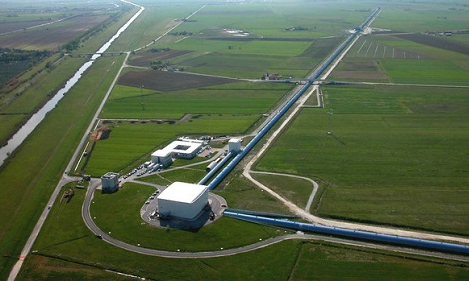LIGO and Virgo interferometer report the first joint detection of gravitational waves. This is the fourth announced detection of a binary black hole system and the first significant gravitational-wave signal recorded by the Virgo detector, and highlights the scientific potential of a three-detector network of gravitational-wave detectors.
Washington (ISJ) – Laser Interferometer Gravitational-Wave Observatory or LIGO in the United States and Virgo interferometer in Italy have reported the first joint detection of gravitational waves. This is the fourth announced detection of a binary black hole system and the first significant gravitational-wave signal recorded by the Virgo detector, and highlights the scientific potential of a three-detector network of gravitational-wave detectors.
The Virgo interferometer is a large interferometer designed to detect gravitational waves predicted by the general theory of relativity. Virgo is a Michelson interferometer that is isolated from external disturbances: its mirrors and instrumentation are suspended and its laser beam operates in a vacuum. The instrument’s two arms are three kilometres long and located near Pisa, Italy.
The three-detector observation was made on August 14, 2017 at 10:30:43 UTC. The two – LIGO Virgo detected a transient gravitational-wave signal produced by the coalescence of two stellar mass black holes. A paper about the event, known as GW170814, has been accepted for publication in the journal Physical Review Letters.
The detected gravitational waves were emitted during the final moments of the merger of two black holes with masses about 31 and 25 times the mass of the sun and located about 1.8 billion light-years away. The newly produced spinning black hole has about 53 times the mass of our sun, which means that about 3 solar masses were converted into gravitational-wave energy during the coalescence.
Gravitational waves can be explained as ripples in the fabric of space-time which can only be caused by massive astronomical events such as neutron stars or black holes orbiting each other so that these waves would finally radiate from them.
“This is just the beginning of observations with the network enabled by Virgo and LIGO working together,” said David Shoemaker of MIT, LSC spokesperson. “With the next observing run planned for Fall 2018 we can expect such detections weekly or even more often.”
“It is wonderful to see a first gravitational-wave signal in our brand new Advanced Virgo detector only two weeks after it officially started taking data,” says Jo van den Brand of Nikhef and VU University Amsterdam, spokesperson of the Virgo collaboration. “That’s a great reward after all the work done in the Advanced Virgo project to upgrade the instrument over the past six years.”
“Little more than a year and a half ago, NSF (the US National Science Foundation) announced that its Laser Gravitational-Wave Observatory had made the first-ever detection of gravitational waves resulting from the collision of two black holes in a galaxy a billion light-years away,” says France Córdova, NSF director. “Today, we are delighted to announce the first discovery made in partnership between the Virgo Gravitational-Wave Observatory and the LIGO Scientific Collaboration, the first time a gravitational-wave detection was observed by these observatories, located thousands of miles apart. This is an exciting milestone in the growing international scientific effort to unlock the extraordinary mysteries of our Universe.”
Advanced LIGO is a second-generation gravitational-wave detector consisting of the two identical interferometers in Hanford and Livingston, and uses precision laser interferometry to detect gravitational waves. Beginning operating in September 2015, Advanced LIGO has conducted two observing runs. The second “O2” observing run began on November 30, 2016 and ended on August 25, 2017.
Advanced Virgo is the second-generation instrument built and operated by the Virgo collaboration to search for gravitational waves. With the end of observations with the initial Virgo detector in October 2011, the integration of the Advanced Virgo detector began. The new facility was dedicated in February 2017 while its commissioning was ongoing. In April, the control of the detector at its nominal working point was achieved for the first time.
The Virgo detector joined the O2 run on August 1, 2017 at 10:00 UTC. The real-time detection on August 14 was triggered with data from all three LIGO and Virgo instruments. Virgo is, at present, less sensitive than LIGO, but two independent search algorithms based on all the information available from the three detectors demonstrated the evidence of a signal in the Virgo data as well.
Indian scientists are collaborating with international research in various aspects of gravitational-wave science over the last three decades.


